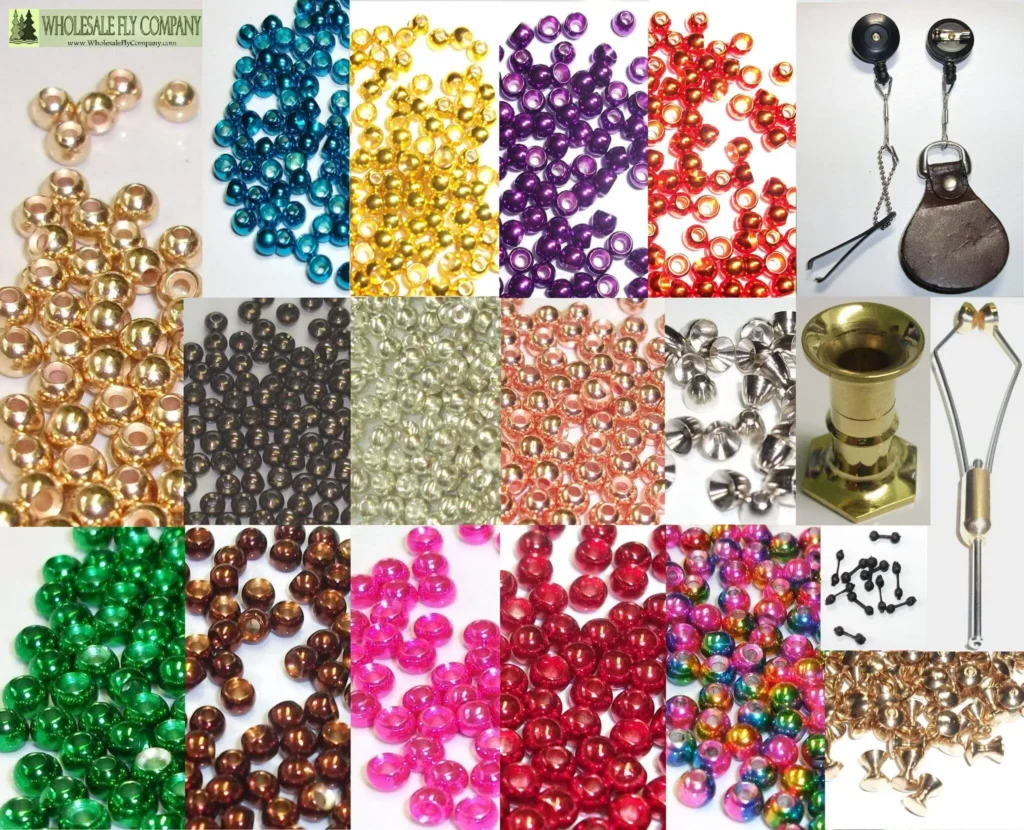Tying and Fishing Beaded Flies: Colors to Use and When to Use Them
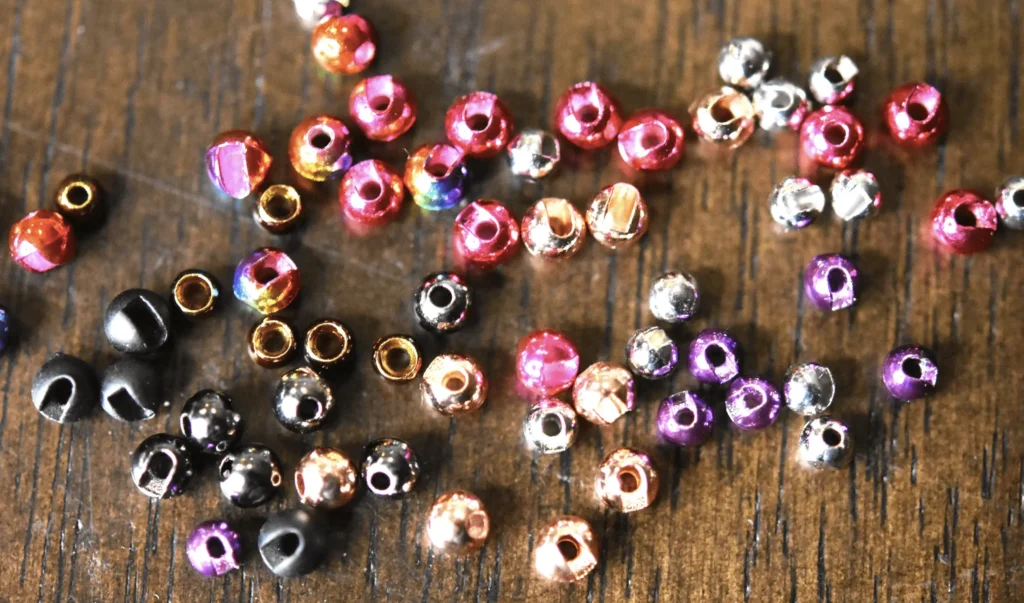
Sometimes too many choices is a bad thing. I can tell you from personal experience that “analysis paralysis” is real, and many times, while scanning lists of fly tying materials, I’ve become so overwhelmed with choices that I ended up buying way more than I wanted, or everything except the color that I actually needed. That’s especially true with brass and tungsten beads, which have become a near-essential component of every subsurface fly pattern in the past 30 years.
I remember fishing in Wyoming with a guide in 1997 and him asking me my thoughts on beadhead flies. He was ambivalent and wanted to write them off as a quirky trend that wouldn’t last. By then, though, beads had been on the scene for about 15 years here in the U.S., longer in European country, so it was clear that beadhead flies were more than a mere trend!
At that time, gold was the main option available to fly tiers and fishermen, at least where I ordered supplies, and I tried to persuade my guide of its merits. I was only 17 at the time and the gold bead Woolly Bugger was the staple of my arsenal. I was also tying for two different local sporting goods stores at the time and any fly tied with a gold bead sold extremely well. So I knew they were popular, and they wouldn’t have been popular if they didn’t work.
Fast forward almost 30 years and beaded flies have become the foundation for whole methods of fly fishing, such as Euro nymphing, and Euro nymphs. Not only that, but catalogues now offer brass, tungsten, and glass beads in so many colors that you’d have to invest a small fortune to try them all. I also base this on personal experience!
That seems to be the case with every material, though. If something is available in one color, it’s likely available in a dozen colors. Each has its merits and fills specific niches in fly tying and in creating patterns to imitate insects and food sources, but beads, I think, are a little more influenced by personal preference. It’s difficult to say whether one color works better than another because there are so many variables. So let’s break down a few of those variables and try to figure out which color beads to use in certain situations.
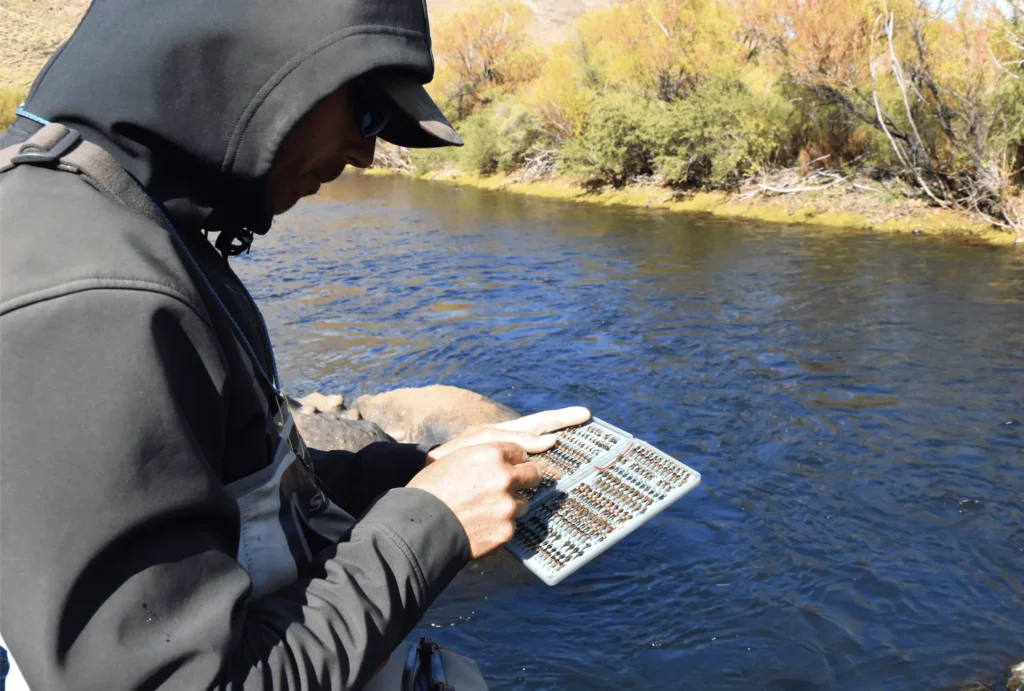
Bead Color for Various Water Colors
In many ways, I feel like gold beads are still what most anglers think of when they consider beadhead nymphs. The classic image is a Prince Nymph with a gold bead, and that is and will always be an effective pattern. But there are some caveats.
On most stocked streams, I think color is situational, meaning that certain colors will perform best in certain water colors and conditions, which can also be said of specific flies. However, on wild trout streams, bead color is a more crucial decision. On some highly pressured wild trout waters that I’ve fished, gold bead nymphs simply will not perform as well as those tied with copper, silver, and even black. If I were to create a chart of factors that go into how I choose which bead colors to use and when, it would look something like this:
Gold – Still the standard for most beaded fly patterns, gold beads will catch wild and stocked fish in all water types. Gold is kind of the “one size fits all” bead color used on most patterns sold in fly shops today, and there’s a reason for it; it works. But it does have the potential to be overused, in my opinion, and on highly-pressured waters, you may find that other colors produce better simply because trout don’t see them as often.
Silver – I use silver beads for wild or stocked trout. Although my “pb” wild brown (watch that video here!) was taken on a fly with a silver bead, this color is especially good for rainbow trout, both stocked and wild – rainbows simply cannot resist silver! This color also excels in low and/or clear water as well as cloudy water. It has just enough sparkle to catch the fish’s attention, but it’s not overpowering.
Nickel – I use this color on many of the same nymphs that I tie with silver beads. Nickel is a more subdued color, which, in my opinion, makes it a little more versatile than bright silver. When I’m tying a box of confidence flies that can be used anywhere I want to fish, I prefer nickel over silver. It works equally well on all trout species.
Copper – A great all-around color that works everywhere, especially for wild trout; wild browns love copper! Copper is a subdued, naturally reddish color, and generally speaking, red is a trigger color for most fish. It is also very visible to trout in all water depths. In deep pools, for instance, red will still be visible to trout when other colors are not, even though it may appear gray or black to fish once it reaches certain depths, so it only makes sense that copper, which contains reddish hues, will also fish well in those situations. And although copper has become more common on fly patterns, it’s not nearly as popular as gold, which makes it more unique. I use copper beads in all water colors and conditions.
Black/Matte Black – This has quickly become a favorite of mine. It’s a natural, subdued color that all trout seem to like, shows up well in most water colors and conditions, and its solid color provides a great contrast to any pattern, almost like a “reverse hot spot.” There are times when more flashy colors will produce better, but there are also instances when black will be the hot ticket.
Fluorescents – These colors fill a very niche role in my fly box. When streams are high and off-color, I do not hesitate to tie on a fly with a fluorescent orange, pink, or chartreuse bead. These colors show up well in murky waters. They also produce in streams and rivers that have a natural cloudiness or tannin color. I will also incorporate these bead colors into egg patterns because they provide a little bit of a hot spot and/or blood dot on the egg.
Metallic – I’m quickly becoming a huge fan of metallic-colored beads in my fly tying and fly fishing. Metallic beads have a greater “depth” of color compared to opaque fluorescent beads and reflect light in a very attractive manner without being overpowering. I use metallic beads a lot when tying my egg patterns, matching the color of the bead with the color of the egg (e.g. pink with pink, orange with cheese and yellow, etc). Also, for more natural nymphs, and especially for wild trout, I use metallic brown, metallic olive, and so on instead of the more traditional colors. Here’s a video for a Perdigon that incorporates the metallic brown bead, which has become a personal favorite.
Does Bead Color Matter? A Case Study
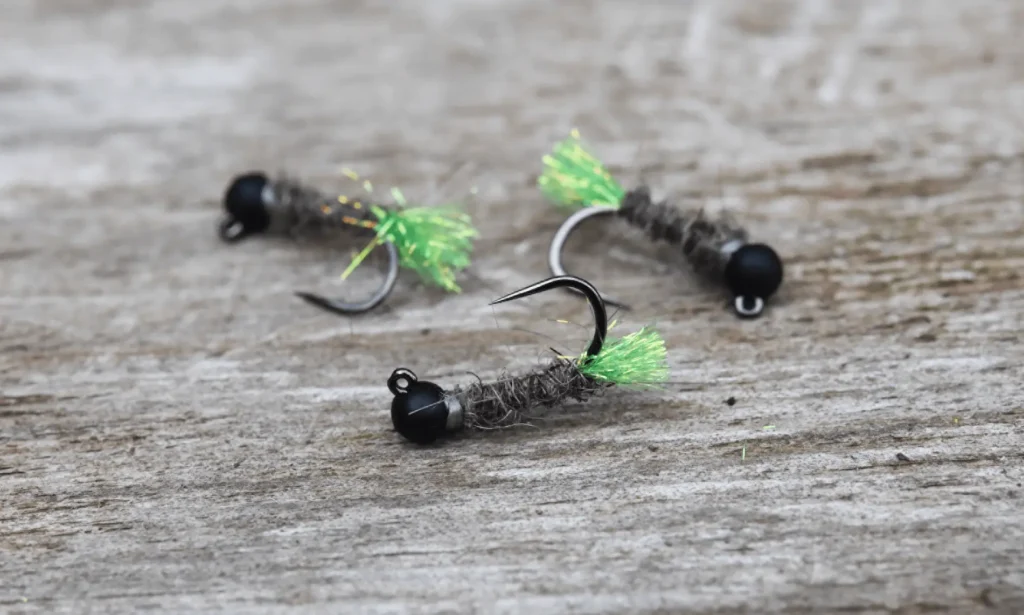
Many times, if I know the pattern I’m using is the correct choice but I’m still not getting the results I want, the first thing I’ll change is bead color. For instance, I was recently guiding a husband and wife new to fly fishing and we timed it perfectly with Grannom activity. During this situation, my first inclination is to use a Green-Assed Walts (affectionately called the “GAW”), my favorite peeking caddis imitation. I tie two versions of this pattern, one with a nickel bead and one with matte black.
That evening with my clients, I put one of each pattern under an indicator and showed them where to cast. The water was low and slow and the sun was beating down on the water.
That section of stream was absolutely loaded with fish. And although both were working over the same water, the client using the GAW with the matte black bead consistently caught more trout. As soon as I realized it, I switched the other over to a GAW with a matte black bead, too, and they soon started hooking fish at a much higher rate.
Unless you have a situation like this where you can see the same pattern tied with two different beads fished side by side, it can be hard to believe that bead color can make that much difference. But truth is, bead color changes a pattern completely, not only in how it looks to us, but in how it looks to the fish.
In low, clear water, for instance, bright flash could be a turn-off – imagine the sun glaring off a mirror and flashing in your face. Not pleasant, right? In the same manner, that flash could cause the trout to look away, and therefore not see the body of the fly attached to it. A matte black bead, on the other hand, produces no reflection and can provide contrast to the fly, which makes the trout notice it and want to eat it even more in low, clear water. As with fly choice, any time you can match the bead to the water color and conditions, you’ll have more fly fishing success.
Tungsten Versus Brass Versus Glass
Let’s take a look at bead density and how it can potentially impact the drift of a fly.
Tungsten – Tungsten has a density of 19.3 grams per cubic centimeter compared to brass at 8.73 grams per cubic centimeter. Technically speaking, and with all other factors being equal, a tungsten bead will reach the stream bottom more than twice as quickly as a brass bead, which is why they are the bead of choice for Euro nymphs. They get down and stay down with less effort or other added weight.
Brass – With a density of 8.73 grams per cubic centimeter, brass beads are not the ideal choice for Euro nymphing, although they can be effective if you’re willing to add extra weight in the form or lead wraps when tying the fly or split shot when fishing it. The inherent negative of adding split shot when fishing brass bead flies European-style is a lack of connection with your nymphs, which can make detecting strikes a little harder. However, for fishing under an indicator, swinging, and general tight-line nymphing, brass beads will perform quite well.
Glass – Glass beads have a density of 2.5 grams per cubic centimeter. Because they are so light, they are ideally suited for midge patterns, emergers, and even soft hackles. They’re not typically used to add weight. Rather, they serve an imitative function, such as body segmentation in caddis pupa, a hot spot, or to represent the gas bubble that midges and chironomids (which aren’t good swimmers) use to float to the surface so that they can hatch.
If you’re a fly tier, you can probably tell the difference between tungsten and brass beads simply by dropping them on a table. Whereas tungsten beads will bounce and quickly settle, brass beads will often hop and roll right off the table edge. I can’t even tell you how many small brass beads I’ve lost in the carpet under my fly tying desk!
On the stream bottom, I imagine tungsten and brass beads will perform in similar ways. Tungsten beads will stay close to the bottom, ticking off the rocks, while brass beaded flies will have a tendency to have a little more bounce and overall movement. This is something to keep in mind when confronted with certain water conditions. Sometimes, you need a fly that will hug the bottom and sometimes you need a little more movement. The key is figuring out which to use in that particular situation.
Slotted, Round, Offset, and Faceted Beads

Slotted Beads – Slotted tungsten beads are primarily used on jig-style hooks designed specifically for tying Euro nymphs. Also, the slotted bead is necessary in order for the bead to sit properly, otherwise it will be canted and awkward looking; the trout may not mind this, but it’s not aesthetically pleasing. I use slotted beads on any hook with a bend that does not easily accept a round bead.
Round Countersunk Beads – Round beads can be brass or tungsten and are usually countersunk and well-suited for “standard” hooks with smooth bends that are easy to slide beads onto.
Offset Beads – These are tungsten beads generally used on standard-shaped nymph and streamer hooks that you wish to convert to Euro-style hooks. Offset beads are almost teardrop-shaped and influence the hook to ride point up along the stream bottom. These Tactical Tungsten Drop Beads are a prime example of this.
Faceted Beads – Faceted beads are typically slotted and made of tungsten (although you can get faceted glass beads from craft supply outlets) and remind me a lot of an insect’s eye. They’re round but the surface is covered with numerous tiny flat spots, each with the potential to reflect a subject or point of light. The result is a multi-dimensional, mottled reflection that can appear very lifelike. Think about it. Very few things in nature are a single, solid color, so these have the potential to be very effective.
Many bead manufacturers and fly tying outlets offer sizing charts for hooks and beads. A general starting point looks something like this:
Hook size 2-4 use a 7/32 or 5.5 mm bead.
Hook size 6-8 use a 3/16 or 4.6 mm bead.
Hook size 8-10 use a 5/32 or 3.8 mm bead.
Hook size 10-12 use a 1/8 or 3.2 mm bead.
Hook size 12-14 use a 7/64 or 2.8 mm bead.
Hook size 16-18 use a 3/32 or 2.4 mm bead.
Hook size 18-20 use a 5/64 or 2.0 mm bead.
Hook size 20-24 use a 1/16 or 1.5 mm bead.
This chart is just a starting point. Personally, I prefer to over-bead by at least one size on most of my Euro nymphs. This allows me to tie a heavier fly while maintaining a smaller profile. Occasionally I’ll even over-bead by two sizes so that I can fish those deep, heavy runs more effectively. Yes, it looks weird. No, the trout don’t seem to mind!
In terms of cost, tungsten is the most expensive type of bead while brass and glass are relatively inexpensive. Of course, actual price will vary from outlet to outlet and brand to brand. I buy most of my brass and tungsten beads from Wholesale Fly Company. If there’s a specific brand I’m looking for, then Precision Fly & Tackle is a good option.
The most important thing, I’ve found, is purchase consistency. Once you find a place that sells beads you are happy with or settle on a brand you enjoy using, try to always buy your beads from that place or of that brand. A 1/8 bead from one manufacturer does not always weigh the same as a 1/8 bead from another manufacturer. There can also be some disparity in the weight of each bead in a single package. The best way to ensure you’re getting beads that will tie and fish the same way as beads you’ve previously tied and fished is by being consistent with your purchasing habits.
When Not to Use Beadhead Flies
This is an important part of the bead discussion because not every situation is suited for a fly with flash or weight. When rivers and streams are running low and clear, and when trout are ultra spooky, sometimes flies with no bead will outperform those with beads. For this reason, I always carry a box of traditional, bead-less patterns with me.
Conclusions
Keep in mind these are just theories. For concrete facts, you’d have to ask the trout what beads they prefer and why. However, just because there are a thousand options for bead colors and styles available on the market doesn’t mean you need to purchase every single one of them and tie every pattern in your box a dozen different ways. The best way to go about bead selection is to find a small handful of colors and learn the situations in which those colors will work best. You can start with specific patterns that call for each type of bead and start your experimentation there, eventually incorporating new bead styles into older patterns.
In many ways, the color and style of beads you use will be chosen in much the same way your fly patterns are selected, and ultimately it comes down to what you have confidence in. If you have confidence that a specific pattern tied with a specific style and color of bead, then you’ll be more likely to fish, and catch fish, with that pattern, and also more likely to start using that style and color of bead more often in other patterns.
Did You Find This Fly Tying Guide To be Helpful?
Stay up to date with the Dark Skies Fly Fishing monthly newsletter for free and receive the latest posts in fly fishing news, tricks, tips, and techniques, stream reports, as well as updates on new flies added to the Online Store and exclusive discounts!
Sign Up NowDownload our eBook "Confidence Flies: Volume One, Euro Nymphs" for free today when you sign up for our newsletter!
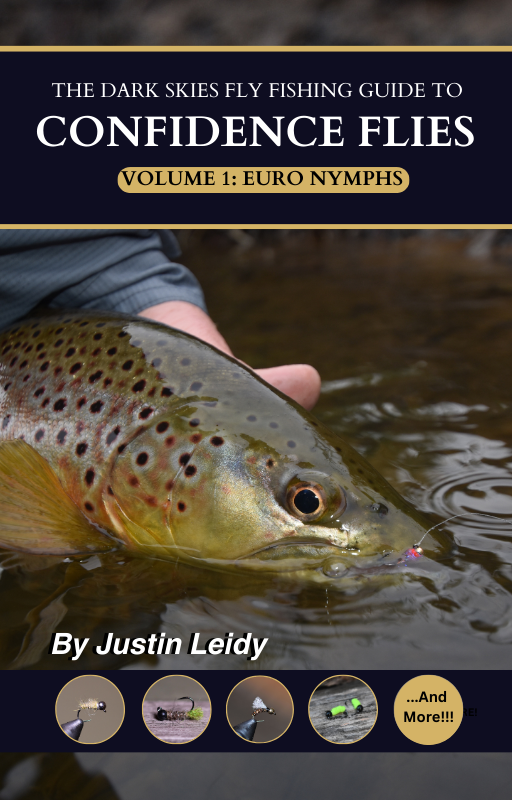
Have a fly fishing question you’d like answered? Drop us a line at info@darkskskiesflyfishing.com! If we use your question in a blog post or in the newsletter, we’ll send you a FREE fly box with a dozen of our favorite nymphs and dry flies!

